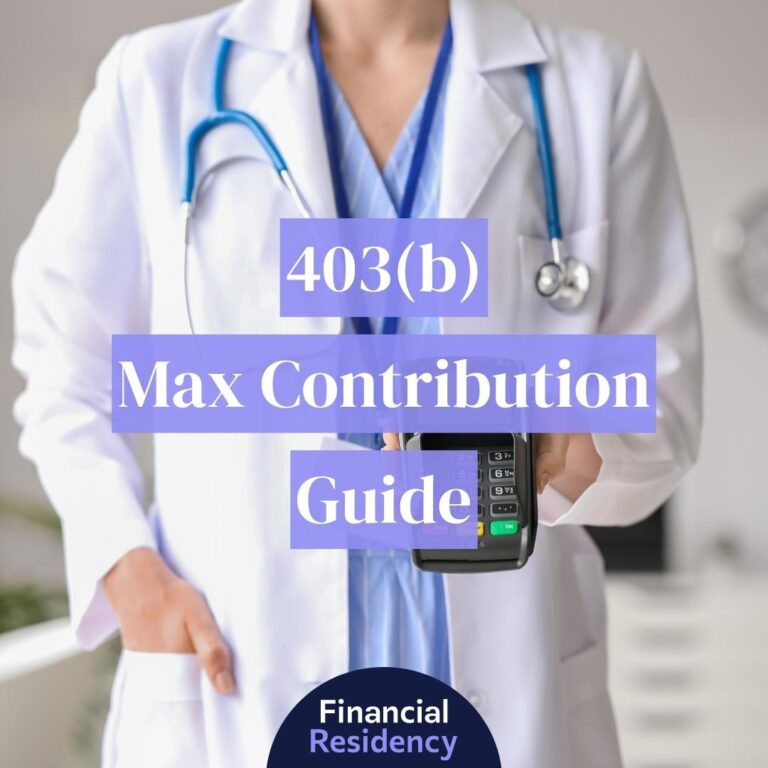To enjoy retirement, you’ll need a retirement savings plan. Physicians have different retirement savings accounts depending on whether they work for someone or themselves.
Determine which account is right for you and learn how to maximize your retirement savings to reach your goals.
Retirement Plans for Doctors
Doctors can use many savings accounts to save or invest for retirement. There isn’t a specific order you must fill up these accounts, but using each account to its full advantage is key.
Many retirement accounts have tax advantages now or during retirement, helping stretch your budget further. Knowing how each account works, its benefits, and how they affect your retirement income can help you create the perfect retirement plan.
Amount Someone Should Save for Retirement
Every doctor needs a different amount of money for retirement. There isn’t a one-size-fits-all number. How much you need depends on your intended lifestyle, living costs, and the time until retirement.
Some doctors downsize their homes and choose to live a simple life after the hustle and bustle of being a doctor for 30+ years. Others love the lavish lifestyle and want to continue living it well into retirement.
Deciding how you want to live, how early (or late) you’ll retire, and what you must take care of during retirement, such as healthcare costs, personal liabilities, or caring for others, will determine how much you need in retirement.
Overall
Most doctors need at least $1 million, if not more, in retirement. But, again, it greatly depends on your lifestyle and obligations. Plus, if you plan to retire 30+ years from now, you must account for inflation and increase your goal number to reach your goals because they will cost more.
Monthly
How much you must save monthly depends on when you start saving. For example, if you save when you’re a resident or fellow and do so consistently for the next 30 years, you could save $600 to $1,000 a month and hit your retirement goals.
On the other hand, if you start saving late, you must make up for lost time and will need to save thousands of dollars a month.
The power of compound earnings is tremendous when saving for retirement. That’s why it’s important to save early. $500 a month at a 10% return for 30 years is over $1 million. But if you waited until age 40 to save $500 a month and retired at 60, you’d have only $382,000. That’s the difference in compound earnings!
Implement the 50/30/20 Rule
To ensure you save enough money for retirement, consider using the 50/30/20 rule. With this rule, you spend only 50% of your income on monthly obligations and living expenses. While it can be tempting to inflate your lifestyle to meet your income, you’re better off investing or saving the funds.
Here’s how it works.
Rule Breakdown
- Spend 50% of your income on bills and the daily cost of living
- Invest or save 30% of your income, save for retirement, pay off debt, and put money away for emergencies
- Spend 20% on whatever you want; it’s discretionary income, and there aren’t any rules
The 50/30/20 plan ensures you put money away regularly for emergencies, retirement, and other long-term goals, allowing the interest to compound.
A Defined Contribution Plan vs. Defined Benefit Plan
There are two main types of retirement accounts employers offer, defined contribution and defined benefit plans. They have one thing in common, and that’s the fact that they are both retirement accounts. But, beyond that, they work differently and have different benefits.
Details About Defined Benefits Plans
Nonprofits and government agencies most often provide defined benefit plans or pensions. With these plans, you don’t make contributions. Instead, your employer makes them on your behalf.
How much they contribute depends on your salary and length of employment. Since defined contribution plans came around, most companies no longer offer defined benefit plans. If they do, they usually aren’t large enough to depend on for retirement.
Details About Defined Contribution Plans
You fund defined contribution plans, the employee. First, you decide what percentage of your income to dedicate to the plan, up to the IRS annual limits. Then, the funds are invested on your behalf, and you can access the contributions and earnings in retirement.
Some employers have an ‘employer match,’ which is a percentage of your salary they’ll contribute if you do. So, if your employer matches 3% of your salary and you make $100,000, if you contribute $3,000, they will, too, for a total of $6,000 in contributions.
Types of Defined Contributions Plans
Private companies have many options when choosing defined contribution plans, including the following:
- Individual (Solo) 401k Retirement Plans – A solo 401k is like a traditional 401k, but it’s for doctors who run their own businesses but don’t have employees. The only exception is if you employ your spouse. Like a traditional 401k, you can set aside a percentage of your income and contribute it to your solo 401k pre-tax. However, you must wait until age 59 ½ to withdraw funds or face a penalty. The maximum contribution in 2023 is $22,500 or 100% of earned income, whichever is less.
- Traditional 401k Retirement Savings Plans – Traditional 401k retirement plans are what most employers offer. First, you decide what percentage of your income you want to set aside for retirement, and the funds are contributed pre-tax. Then, you choose how the funds are invested, including stocks, bonds, options, futures, and ETFs, and the contributions and earnings grow tax-deferred. When you withdraw the funds in retirement, you pay taxes at your current tax rate. If you withdraw before age 59 ½, you’ll pay a 10% penalty plus your current tax rate on the funds. The maximum contribution in 2023 is $22,500. If you’re 50 or older, you may contribute up to $7,500 as a catch-up contribution.
- 403b Retirement Savings Plans – If you work for a government agency, non-profit, or hospital, your organization may offer a 403b instead of a 401k. They have the same premise, including contribution limits and withdrawal requirements. However, 403b accounts don’t have the same tax rates as 401k accounts for employers, so many organizations match employee contributions.
- 457b Retirement Savings Plans – If you work for a non-profit organization, they may offer a 457b. This retirement account allows you to save a portion of your income for retirement, tax-deferred. However, unlike a traditional 401k, you can withdraw funds for a medical emergency before retirement without paying the penalty. Like 401k accounts, the maximum contribution for a 457b is $22,500 or 100% of your gross income.
- 401a Retirement Savings Plans – A 401a retirement savings plan is another option for nonprofits to offer their employees. It works like a 401k, except employer contributions are required, so it’s well worth accepting if your employer offers this account. The maximum contribution for a 401a plan is $66,000 for 2023.
- Profit-Sharing Retirement Savings Plans – A profit-sharing plan is another retirement plan option employers can have on their own or in addition to a 401k. It allows employers to share company profits with employees. Employers have different options for sharing the profits with employees and can contribute up to $66,000 or 100% of compensation, whichever is less, plus an additional $7,500 for those over age 50.
- Cash-Balance Retirement Savings Plans – A cash-balance plan is a lot like a pension. It’s employer-funded, and you cannot control how much you receive at retirement. However, the difference between a cash balance plan and a pension is that your employer can invest the funds to make them grow. Your employer is still responsible for the promised amount upon retirement if the market crashes. Cash balance plans have much higher contribution limits, with limits as high as $420,000.
Non-Qualified vs. Qualified Retirement Plans
It’s important to know the difference between non-qualified and qualified retirement plans, as they can affect your tax liability and how you receive the funds in retirement.
Details About Qualified Retirement Plans
Qualified retirement plans are your typical plans, such as 401k, 403b, and 401a. They are qualified because they meet the Employee Retirement Income Security Act rules. They are also overseen by the IRS and have different tax rules, either before contribution or during retirement.
The ERISA ensures employers fairly distribute the accounts, making all employees eligible for the same accounts and employer-match amounts. In addition, all accounts are tax-deferred, meaning you don’t pay taxes when you contribute, but you’ll owe taxes on all contributions and earnings when you withdraw during retirement.
Details About Non-Qualified Retirement Plans
Non-qualified plans, as the name suggests, aren’t subject to the same rules. The ERISA doesn’t oversee them, and the IRS has fewer rules.
For example, employers don’t have to offer them to everyone; they are usually reserved for higher-income earners, such as doctors.
Because the ERISA rules don’t apply, most plans require you to pay taxes upfront, and the money plus earnings grow tax-deferred until you withdraw it.
Different Retirement Plans for Different Doctors
Each type of doctor has different retirement plan options. For example, they may offer an employer-sponsored plan if you work for someone. If you work for yourself, the IRS offers options for tax-deferred retirement savings, and anyone can open a taxable account to save for retirement.
Retirement Plans for Employed Doctor
If a hospital or medical group employs you, your employer determines the type of retirement benefits they offer, but the most common is the 457b, 403b, 401k, and 401a.
457b Plan
The 457b plan is offered by nonprofits that don’t provide 403b (the non-profit version of a 401k) plans. You can defer a portion of your salary with the 457b and aren’t subject to the same age restrictions if you withdraw funds early.
The downside of 457b plans is that they aren’t protected accounts. For example, if your employer goes out of business, they could use your 457b funds to pay off creditors. You also may be unable to roll over the funds if you leave the job unless your new job has a 457b plan.
403b Plan
A 403b plan is like a 401k plan but for non-profits. You determine what percentage of your income you’ll set aside and won’t pay taxes on it. In addition, some employers offer the option to make Roth contributions, which means you contribute after tax.
Most 403b plans have mutual funds you can choose from to invest your money. All contributions and earnings grow tax-deferred, and you pay your current tax rate in the year you withdraw the funds.
401k Plan
A 401k plan is a traditional retirement account offered by most employers. Your employer may match a percentage of your salary if you contribute to your account. Earnings and contributions grow tax-deferred until you withdraw the funds.
Employer determines your investment options, but you can choose among those options to invest the funds according to your risk tolerance and timeline.
401a Plan
A 401a plan is more employer-driven, as the employer makes all the rules. For example, your employer could determine what percentage of your pay you’ll contribute to the account, and they’ll do the same. They may also state that they will make all contributions.
All contributions are pre-tax, and you decide how the funds are invested. The employer also reserves the right to change the plan’s rules.
Retirement Plans for Self-Employed Doctor
If you’re self-employed, saving for retirement is even more important. Because you don’t have an employer saving on your behalf, you may need to take advantage of these accounts with higher contribution limits to help reach your retirement goals.
SEP IRA (Traditional IRA) Plan
A SEP IRA is the most straightforward plan for self-employed doctors. All contributions are pre-tax; you can contribute up to $66,000 annually in 2023. Because you’re in charge, you can set the account up anywhere and contribute how much you want, up to the limits.
Individual 401k Plan
An individual 401k plan is like an employer-sponsored plan, except you are the employer and the employee. On the employee side, you can contribute up to $22,500 in 2023, plus $7,500 if you’re over 50. On the employer side, you can contribute up to 25% of compensation before tax, up to $66,000 total.
Simple IRA
If you have employees (fewer than 100), you can set up a SIMPLE IRA, which has fewer requirements than a 401k for employers. However, the contribution limits are lower at $15,500 under 50 and $19,000 over 50.
Pension Plans
Self-employed doctors also have the option of a pension plan. This can work well if you have more money to set aside for retirement but max out your individual 401k plan. A cash balance pension plan is a retirement fund paid for by the employer (you, in this case) with a guaranteed rate of return.
If the account doesn’t perform as you promised, you must make up the difference the following year to provide the promised retirement funds.
Retirement Plans for Physician Families
If you’re married, you might also consider setting up a retirement account for your spouse. This will ensure that both parties are set financially, no matter what the future holds.
Spousal or Roth IRA
A spousal traditional or Roth IRA allows non-working spouses to save for retirement. For example, if you’re working as a doctor, your earnings cover the contribution, allowing your spouse to have funds invested for retirement.
You can open a traditional (pre-tax) IRA or Roth IRA (after-tax). If it’s a traditional IRA, your spouse will pay taxes as they are withdrawn. If it’s a Roth IRA, the contributions and earnings grow tax-free.
HSA (Health Savings) Plan
A Health Savings Plan is a great way to save for healthcare and get tax advantages. HSAs are pre-tax, and your contributions and earnings grow tax-free. In addition, the funds are tax-free if you use them for eligible medical expenses.
You can roll the funds over each year, allowing you to save money for retirement and enjoy tax benefits.
Taxable and Tax-Exempt Plans
If you’ve maxed out your retirement accounts, you can invest the funds in a taxable account or certain tax-exempt investments, such as bonds. This can be another way to further your retirement funds without any restrictions.
Bonds
If you invest in bonds, you may avoid federal taxes on the interest and possibly state tax if you live in the state where you purchased the bonds.
Bonds are a conservative investment with a fixed rate of return, giving you some stability in your investment portfolio.
Mutual Funds
Mutual funds are a good option for retirement investments if they have low turnover and don’t pay capital gains frequently. If you keep the investments long-term, your savings can grow without the tax burden of capital gains.
Watch the load fees on mutual funds, and find funds that are passively managed to avoid excessive fees or triggering taxes on capital gains.
Low-Cost Index Funds
Low-cost index funds are also passively managed investments with low tax rates. If the funds aren’t actively bought and sold, you don’t receive capital gains and can’t be taxed. This allows you to keep your funds invested and let them grow long-term.
Stocks
Stocks are a great way to invest for retirement. If you use tax-loss harvesting techniques and sell some stocks at a loss to offset the capital gains on others, you can increase your earnings for retirement.
Keeping stocks for over one year reduces your tax liability by subjecting you to long-term capital gains taxes, which are lower than short-term capital gains taxes.
How to Maximize Your Retirement Plan
Maximizing your retirement plan now helps you have the funds you need in retirement. Here are the best ways to maximize your earnings.
1. Start Saving Immediately
The best time to save for retirement was yesterday, so if you haven’t started, do so now. Even in your 20s, you should start saving for retirement. The more time your money has to grow, the more you’ll have for retirement.
As a bonus, the earlier you save, the less you must save per month, but you can achieve the same retirement goals thanks to compound earnings.
2. Adjust Your Spending
Rather than spending every dollar you make or trying to keep up with friends and family, live within your means. Reduce your spending to save a large portion of your income, rather than spend it just to have flashy cars or a big house.
Live comfortably, but don’t feel you must elevate your lifestyle to meet your income. Instead, think of your long-term goals.
3. Diversify Your Retirement Assets
Diversifying is the key to a successful retirement. Diversifying your capital reduces the risk of a total loss if one asset performs poorly. Usually, diversified assets are affected differently by the market. Consider investing in stocks, bonds, ETFs, real estate, futures, and options to diversify your investment funds.
4. Maximize Your Contributions
Try to contribute as much as possible up to the annual limits for each plan. This is especially important if any of your retirement accounts have an employer match. It’s like getting free money and doubling your investment.
Many retirement accounts have tax benefits for the contributions, so it pays to maximize your contributions and decrease your tax liabilities.
Starting Your Retirement Savings Plan
To start your retirement plan, creating a strategy, learning how to save, and choosing the plan that suits your needs is essential.
Work With a Financial Planner
Hiring a financial planner is the best way to ensure you reach your retirement goals. Don’t invest blindly, assuming you’ll get your goals. Instead, employ a professional who can handle your finances and help you allocate them to maximize your retirement funds.
Develop a Realistic Plan For Saving
Start saving early, but be realistic about how much you can save. Ideally, you should save as much as 20% or more of your income, but if that’s not possible immediately, that’s okay.
The key is to set a realistic budget for saving for retirement and then increase the contributions as your income increases. You can also increase your contributions as you pay down your debts and have more money to invest.
Choose the Right Retirement Plan For You
You need a retirement plan to save for retirement. If you work for someone, check out the employer-sponsored plan and take advantage of any employer match. If you work for yourself, talk to your financial advisor about the best plan for your situation to help you make the most of your retirement funds.
Frequently Asked Questions
Saving for retirement can feel complicated. Here are some common questions doctors have about it.
Do doctors have benefits in retirement?
You may have different benefits depending on whether you work for yourself or an employer. Most plans today are defined contribution plans, which means you contribute to your retirement account by setting aside a portion of your income. However, some employers offer pension plans, giving doctors supplemental retirement income.
What is the average amount of money doctors retire with?
Most doctors retire with at least $1 million, but it varies by person, goal, and how long they work. The key is to set up a retirement plan that allows you to contribute regularly, earns compound interest, and helps you reach your retirement goals.
What are medical retirement plans, and how do they differ from other retirement plans?
A medical retirement means you retired due to medical issues, aka a disability. This is most common in the military but may be evident for physicians too. Instead of collecting Social Security Income for retirement, you’d collect disability income and any other potential retirement funds available.
Why do doctors often work beyond retirement age?
Doctors work beyond retirement because they are attached to their profession. They work so much during their working years that they don’t know much else, so leaving can be emotional and complicated.
Are there specific retirement rules?
There are many retirement rules you can use, but the most common are the following:
- 80% retirement rule – You should be able to produce 80% of your last year’s income annually during retirement for comfortable living. Of course, this will vary by the doctor as some can live on less than 80%, and others need more.
- 20% retirement rule – Aim to save 20% of your annual income for retirement. This allows you to focus on the long-term and get tax advantages on your income while reaching your retirement goals.
- 4% withdrawal rate – Ideally, you should be able to live on 4% of your total retirement balance annually, so you don’t outlive your funds.
Retirement Plans for Doctors: Bottom Line
There are many retirement plans for doctors, and they aren’t one-size-fits-all. Determine which plan works for you, set up a contribution plan, and adjust your contributions as your income increases. This will help you reach your long-term retirement goals!




